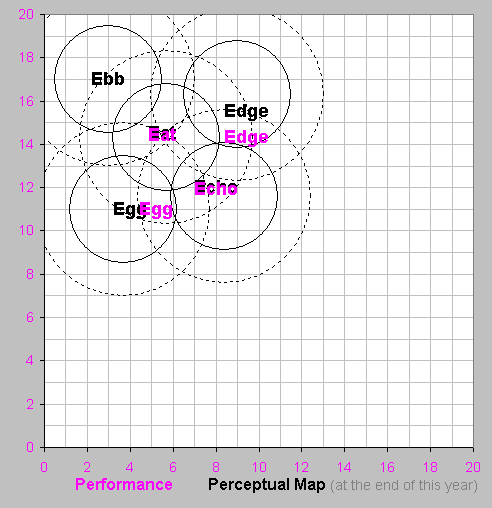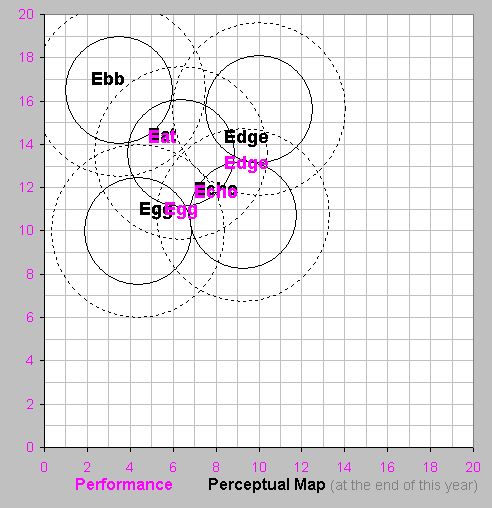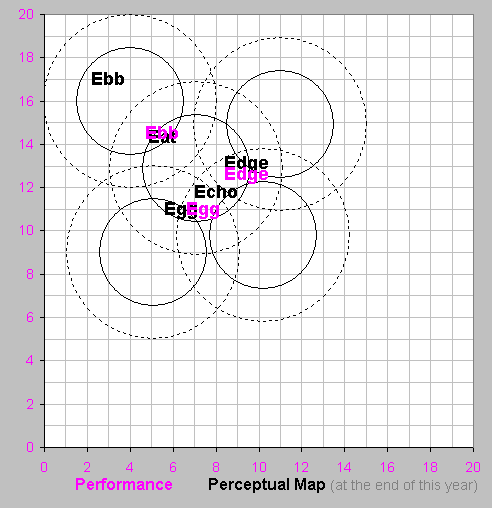This practice exercise will help you understand the relationships between business strategy, tactics, functional alignment, and the Capstone® simulation. We will use the Erie team for this example. (During the practice rounds, each company is assigned a different strategy.)
Printable PDF Version for Distribution to Participants
You will execute your plan by inputting the decisions described below. At the same time, your competitors will execute their assigned plans. The practice exercise will take three rounds As each round is processed, you will evaluate the results and then input the next round's assigned decisions.
Upon completion of the practice rounds, the simulation will be reset to the beginning. You can then create and implement your own strategic plan for the actual competition.
We will adopt a Niche Cost Leader Strategy, concentrating on the Traditional and Low End segments. We will gain a competitive advantage by keeping R&D costs, production costs, and raw material costs to a minimum, enabling us to compete on the basis of price. Our Cost Leader orientation will allow us gain a competitive advantage based upon low prices. Our products will keep pace with the market, offering improved size and performance. We will price below average. We will increase automation levels to improve our margins and to make it acceptable to run a second shift).
Reliable products for low technology customers: Erie brands offer value. Our primary stakeholders are bondholders, stockholders, customers, and management.
We will concentrate our existing product line into the Low End and Traditional segments. Eat and Ebb will serve the Low End segment. Echo, Edge, and Egg will serve the Traditional segment. During the early years we will migrate (gradually) our Performance and Size segment products (Edge and Egg) to the Traditional segment. We will allow Eat (Traditional) to slip into the Low End while Edge (High End) slips into the Traditional segment.
We will maintain awareness and accessibility in our targeted segments. After we establish our cost leadership position we will revisit our situation to decide whether sales and promotion budgets should be reduced or if we should keep pace with our competitors. Our prices will be lower than average. While Edge and Echo are being repositioned, we will price somewhat below and discontinue sales budgets as we exit the specialty Performance and Size segments.
We will significantly increase automation levels on our products. However, because automation sets limits upon our ability to reposition products with R&D, we will postpone automation for Edge and Egg until they arrive in the Traditional Segment. We will prefer second shift to capacity expansions.
We will finance our investments primarily through long-term bond issues, supplementing with stock offerings on an as needed basis. When our cash position allows, we will establish a dividend policy and begin to retire stock. We are not adverse to leverage, and expect to keep debt/equity between 2.0 and 3.0.
Follow the decisions below. After the practice rounds are complete and the competition rounds begin, you are free to choose a different strategy; you are not obligated to continue as a Niche Cost Leader.
Eat - Tweak positioning to reduce age. Reduce reliability (MTBF) to reduce material cost. Example: Decrease Eat's size by 0.1 and reduce MTBF by 1000 hours.
Ebb - Leave positioning alone, allowing the product to age further. Reduce reliability (MTBF) to reduce material cost. Example: Reduce Ebb's MTBF by 1000 hours.
Echo - Tweak positioning to reduce age. Reduce reliability (MTBF) to reduce material cost. Example: Reduce Echo's size by 0.1 and reduce MTBF by 1000 hours.
Edge - Begin migration towards Traditional segment. Reduce reliability (MTBF) to reduce material costs. Example: Decrease size by 1.2 and reduce MTBF by 1000 hours.
Egg - Begin migration towards Traditional segment. Reduce reliability (MTBF) to reduce material costs. Example: Increase performance by 1.2 and reduce MTBF by 1000 hours.
Important: Make certain that the projects complete during this year before December 31st. Under the rules, a new project can only begin on January 1st. If these projects do not complete before the end of this year, you cannot begin follow-up projects next year.

Perceptual Map from the Research & Development Spreadsheet: Product names in black indicate the product's current location, names in magenta indicate the product's revised position (with slight revisions, the names will overlap). Names of newly invented products appear in magenta.
Eat - Make moderate cuts in price, promotion, and sales budgets. Forecast increased sales over last year, driven by an improved age and price cut. Example: Price $27.00, promotion budget $900, sales budget $900, and sales forecast 1400.
Ebb - Make moderate cuts in price, promotion, and sales budgets. Forecast unit sales near last year's level. Example: Price $20.00, promotion budget $900, sales budget $900, and sales forecast 1700.
Echo - Make moderate cuts in price, trim promotion budget, and slash sales budget. Forecast unit sales near last year's level. Example: Price $37.50, promotion budget $900, sales budget $500, sales forecast 400.
Edge - Make moderate cuts in price, trim promotion budget, and slash sales budget. Forecast unit sales near last year's level. Example: Price $32.50, promotion budget $600, sales budget $100, sales forecast 350.
Egg - Make moderate cuts in price, trim promotion budget, and slash sales budget. Forecast unit sales near last year's level. Example: Price $32.50, promotion budget $600, sales budget $100, sales forecast 350.
Production schedules will plan for eight weeks of inventory. That is, have enough inventory on hand to meet demand eight weeks beyond the sales forecast. This requires a 15% inventory cushion (8/52 = 0.15). For example, suppose Marketing forecasts demand at 1000, and you have 100 units in inventory. You want 1000 x 115% = 1150 available for sale. Since you have 100 on hand, you would schedule 1050 for production.
If you cannot meet demand, sales go to competitors. Therefore, you want to plan for the upside as well as the downside. Your proforma balance sheet will forecast about eight weeks of inventory. You hope that your actual sales will fall between your sales forecast and the number of units available for sale.
For each product, schedule production using the formula:
(Unit Sales Forecast X 1.15) - Inventory On Hand.
Eat - Increase automation level by 1.0 or 2.0 points.
Ebb - Increase automation level by 1.0 or 2.0 points.
Echo - Increase automation level by 1.0 or 2.0 points.
Edge - No change.
Egg - No change.
Important: There is a one year lag between purchase and use of new capacity and automation for both new and existing products.
Your fiscal policies should maintain adequate working capital reserves to avoid a liquidity crisis. Working capital can be thought of as the money that you need to operate day-to-day. In Capstone® working capital is current assets (cash + accounts receivable + inventory) - current liabilities (accounts payable + current debt). If you run out of cash because your sales are unexpectedly weak, an Emergency Loan will be issued.
Here are some guidelines to help you avoid an Emergency Loan . Your proforma balance sheet predicts your financial condition at the end of this year. Make conservative sales forecasts. Do not rely on the computer prediction. Override it with a forecast of your own. If you are conservative, it is unlikely that your worst expectations will be exceeded. Next, build additional inventory beyond your conservative expectations. This forces your proforma balance sheet to predict a future where your sales forecast comes true and you are left with inventory. (If you sell the inventory, that's wonderful.) On the Finance spreadsheet, issue stock, bonds or current debt until the December 31 Cash Position for the upcoming year equals at least five percent of your assets, as displayed on the proforma balance sheet. This creates an additional reserve for those times when your worst expectations are exceeded and disaster strikes.
As you gain experience with managing your working capital, you will observe that the guidelines above make you somewhat "liquid," and you may wish to tighten your policy by reducing cash and inventory projections. That is fine. The better your marketing forecasts, the less working capital you will require.
Match your plant investment with a long-term bond. If you do not have sufficient new bond debt capacity, issue stock to cover the shortfall.
Pay a dividend between $0.50 and $1.00.
Do not issue current debt.
Save decisions (select "directly to the website").
Eat - Tweak positioning to reduce age. Reduce reliability (MTBF) to reduce material cost. Example: Decrease Eat's size by 0.1 and reduce MTBF by 1000 hours.
Ebb - Leave positioning alone, allowing the product to age further. Reduce reliability (MTBF) to reduce material cost. Example: reduce Ebb's MTBF by 1000 hours.
Echo - Tweak positioning to reduce age. Reduce reliability (MTBF) to reduce material cost. Example: Decrease Echo's size by 0.1 and reduce MTBF by 1000 hours.
Edge - Continue migration towards Traditional segment. Reduce reliability (MTBF) to reduce material costs. Example: Decrease Edge's size by 1.2 and reduce MTBF by 2000 hours.
Egg - Continue migration towards Traditional segment. Reduce reliability (MTBF) to reduce material costs. Example: Increase performance by 1.2. and reduce MTBF by 1000 hours.

Eat - Offer a price cut to the lower end of the Traditional price range. Hold promotion and sales budgets near current levels. Forecast unit sales near last year's level. Example: Price $20.00, promotion budget $900, sales budget $900, and sales forecast 1300.
Ebb - Hold price, promotion budget, and sales budget steady. Forecast unit sales near last year's level. Example: Price $20.00, promotion budget $900, sales budget $900, and sales forecast 1700.
Echo - Make moderate cuts in price, hold promotion and sales budgets steady. Forecast unit sales near last year's level. Example: Price $36.00, promotion budget $900, sales budget $500, sales forecast 450.
Edge - Make moderate cuts in price, hold promotion and sales budget steady. Forecast unit sales near last year's level. Example: Price $31.00, promotion budget $600, sales budget $100, sales forecast 320.
Egg - Make moderate cuts in price, hold promotion and sales budget steady. Forecast unit sales near last year's level. Example: Price $31.00, promotion budget $600, sales budget $100, sales forecast 300.
For each product, schedule production using the formula:
(Unit Sales Forecast X 1.15) - Inventory On Hand
Eat - Increase automation level by 2.0 or 3.0 points.
Ebb - Increase automation level by 2.0 or 3.0 points.
Echo - Increase automation level by 2.0 or 3.0 points, not to exceed an automation level of 8.0.
Edge - No change.
Egg, - No change.
Match your plant investment with a long-term bond. If you do not have sufficient new bond debt capacity, issue stock to cover the shortfall.
Look at the proforma balance sheet, and add together your cash and inventory accounts. Apply the following rule of thumb. Keep between 15% and 20% of your balance sheet assets in cash plus inventory. You do not care about the mix, but you do want to have adequate reserves to cover unexpected swings in inventory.
Adjust your cash position to meet the guideline from Round 1. If you are cash poor, issue stock. If you are cash rich, pay dividends and buy back stock.
Do not issue current debt.
Save decisions (select "directly to the website").
Eat - No change to positioning. Set MTBF to 14000 hours (the bottom of the Traditional range.) Note that Eat is about to become a Low End product.
Ebb - Reposition Ebb to the current leading edge of the Low End segment. This will take 2.0 to 2.5 years, and it will sacrifice both positioning and age. It is necessary, however, to keep Ebb within the Low End segment in the long run. Example: Increase Ebb's performance by 2.5 and decrease size by 2.5.
Echo - Note that Echo is now within the Traditional segment. Traditional customers want an ideal age of 2.0 years. If necessary, tweak positioning to reduce age so that sometime during the year Echo will be 2.0 years old. It may not require a positioning tweak. Reduce reliability (MTBF) to 19000.
Edge - Enter the Traditional segment. Reduce reliability (MTBF) to the middle of the Traditional customer's acceptable range. Example: Decrease size by 0.5, and reduce MTBF by 5000 hours.
Egg - Enter the Traditional segment. Leave reliability (MTBF) in the middle of the Traditional customer' s acceptable range. Example: Increase performance by 1.0.

Eat - Offer a price cut. Hold promotion and sales budgets near current levels. Expect Eat to sell to both Traditional and Low End customers, but since Eat does not offer a good product to either segment, plan for decreased sales. Example: Price $20.00, promotion budget $900, sales budget $900, and sales forecast 1300.
Ebb - Hold price, promotion budget, and sales budget steady. Forecast unit sales near last year's level. Example: Price $20.00, promotion budget $900, sales budget $900, and sales forecast 1800.
Echo - Cut price, hold promotion budget steady and increase sales budget. Remember, Echo has left the High End. It is now in the Traditional fine cut, with poor positioning and age, therefore forecast low sales when compared to other products in the Traditional segment. Example: Price $26.00, promotion budget $900, sales budget $900, sales forecast 900.
Edge - Cut price, hold promotion budget, and increase sales budget. therefore forecast low sales when compared to other products in the Traditional segment. Example: Price $27.00, promotion budget $600, sales budget $600, sales forecast 900.
Egg - Cut price, hold promotion budget, and increase sales budget. therefore forecast low sales when compared to other products in the Traditional segment. Example: Price $27.00, promotion budget $600, sales budget $600, sales forecast 900.
For each product, schedule production using the formula:
(Unit Sales Forecast X 1.15) - Inventory On Hand
Eat - Increase automation level by 1.0 or 2.0 points, not exceed the maximum level of 10.0.
Ebb - Increase automation level by 1.0 or 2.0 points, not exceed the maximum level of 10.0.
Echo - Increase automation level by 1.0 or 2.0 points, not to exceed an automation level of 8.0.
Edge - Increase automation level by 1.0 or 2.0 points.
Egg - Increase automation level by 1.0 or 2.0 points.
Adjust your cash position to meet the guideline from Round 1.
Do not retire long-term debt. Use excess cash to buy back stock and pay dividends.
Save decisions (select "directly to the website").
Your instructor might want you to play another practice round. If so, continue the Niche Cost Leader vision.
Having executed the plan for two or three rounds, you are now in a position to analyze it. Consider the following questions:
What are this plan's strengths? Weaknesses?
How will competitors respond to your actions?
How can you influence competitors to avoid competing with you directly?
Which performance measures support this plan?
What is the long range potential of this plan? Its future sales volume? Its future profitability?
How can you best coordinate this plan as a team?